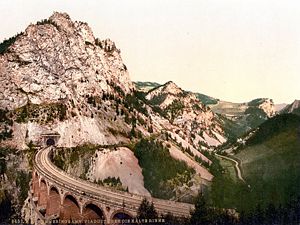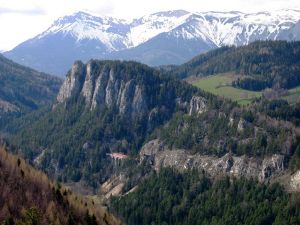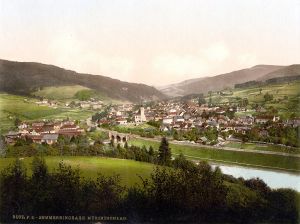Semmering Railway
| Semmering Railway* | |
|---|---|
| UNESCO World Heritage Site | |

| |
| State Party | |
| Type | Cultural |
| Criteria | ii, iv |
| Reference | 785 |
| Region** | Europe |
| Inscription history | |
| Inscription | 1998 (22nd Session) |
| * Name as inscribed on World Heritage List. ** Region as classified by UNESCO. | |
The Semmering Railway, Austria, which starts at Gloggnitz and leads over the Semmering to Mürzzuschlag was the first mountain railway in Europe built with a standard gauge track. It is commonly referred to as the world's first true mountain railway, given the very difficult terrain and the considerable altitude difference that was mastered during its construction.
It's construction made Austria a pioneer in the building of alpine railways on long, steep escarpments. It is located at N47 38 55.6 E15 49 40.7 and is still fully functional as a part of the Austrian Southern Railway. In 1998 it was named a World Heritage Site and in 2004 it celebrated its 150th anniversary.
Background
The Semmering Railway was named a World Heritage Site in 1998 after it was determined it had outstanding universal value and it met two of the 10 selection criteria.
The first criteria it met was that it represents an outstanding technological solution to a major physical problem in the construction of early railways.
Second, with the construction of the Semmering Railway, areas of great natural beauty became more easily accessible and as a result these were developed for residential and recreational use, creating a new form of cultural landscape.
History
The Semmering Railway was constructed between 1848 and 1854 by some 20,000 workers under the project's designer and director Carl von Ghega. The construction features 14 tunnels (among them the 1,431 m vertex tunnel), 16 viaducts (several two-story) and over 100 curved stone bridges as well as 11 small iron bridges. The stations and the buildings for the supervisors were often built directly from the waste material produced in the course of tunnel construction.
Across an overall track length of 41 km the Semmering Railway masters an altitude difference of 460 m; on 60 percent of its length the steepness is 20-25 percent (equivalent to a 1-meter difference in altitude on a 40 m route distance), and 16 percent exhibit a curvature radius of only 190 m. This was an entirely new technical dimension for railway construction, and new instruments and methods of surveying had to be developed to handle the resulting challenges. Also, new technologies were employed for the Engerth locomotives because the types in general use at this time could not handle the extreme gradients and turning radii.
While being built the Semmering Railway was perceived as "landscape gardening," because it attempted a harmonious combination of technology and nature. The unique travel experience that the Semmering Railway offered contributed significantly to the original opening of the Semmering region to tourism. Numerous hotels and mansions that date to the railways early days are still functional. This enormous upswing to the turn of the century and the revaluation of the region as a winter sports area in the first third of the 20th Century were interrupted first by World War I and then by the changed recreational needs of the population. Therefore this unique culture landscape could be preserved with little change.
The Semmering railway line is part of the Südbahn railway that runs between Vienna and Graz, continuing on to Maribor, Ljubljana and eventually to Trieste.
Semmering Pass
The Semmering is a mountain pass in the Eastern Northern Limestone Alps that forms a natural border between Lower Austria and Styria. The Semmering Railway passes 282 ft. below the summit of the Semmering Pass (3225 ft.) by tunnel.
The railway led to the development of a vacation resort for the people of Vienna and the construction of several hotels. In the early 1900s, the hotels on the Semmering were among the leading hotels of the Alps, and hosted high-class visitors from throughout the Habsburg empire. The leading hotels - the Panhans, Südbahnhotel and Erzherzog Johann - were joined in 1909 by a fourth luxury hotel, the Semmeringer Kurhaus. During the World War I, it was known as the Physical-Dietetic Mountain Convalescent Home and served as an exclusive convalescent home for officers.
In December 1938, the Kurhaus was taken over by the Wehrmacht and converted into a "German military convalescent hospital", where leading figures of the Third Reich went to convalesce.
Following World War II, the Russians occupied the Kurhaus, as the boundary with the British zone ran exactly along the Semmering Pass.[1]
Today winter sports and Summer hiking are the top draws for the town. The Semmering ski resort, which hosts Alpine skiing World Cup events, is located at the pass and extends on the Hirschenkogel mountain. Today it is mainly used by skiers from Vienna, from where it can be reached within one hour, but increasingly is used by people from Hungary and Slovakia.
The Railway in numismatics
The Semmering Alpine Railway has been the main motive for may collector coins and medals. One of the most famous and recent ones is the 150 Years Semmering Alpine Railway Coin. The obverse shows two locomotives: a historical and a modern one. The reverse of the coin shows a typical Semmering view. An Engerth steam locomotive just emerged from a tunnel crossing one of the distinctive viaducts.
Notes
- ↑ The Kurhaus Sanatorium on the mountain of Semmering Alma-mahler.at. Retrieved June 29, 2008.
ReferencesISBN links support NWE through referral fees
- Semmering the Magic Mountain Semmering.or.at.
External links
- World Heritage Site
- History of the building of the Semmering-Railway
- Ole Oest. 2007. Semmering Railway, Austria
- Photo tour of Semmering Railway
- Austria's World Heritage Sites
- Austria 360
- James Martin. 2006. Scenic Train Routes in Austria Goeurope.about.com.
Credits
New World Encyclopedia writers and editors rewrote and completed the Wikipedia article in accordance with New World Encyclopedia standards. This article abides by terms of the Creative Commons CC-by-sa 3.0 License (CC-by-sa), which may be used and disseminated with proper attribution. Credit is due under the terms of this license that can reference both the New World Encyclopedia contributors and the selfless volunteer contributors of the Wikimedia Foundation. To cite this article click here for a list of acceptable citing formats.The history of earlier contributions by wikipedians is accessible to researchers here:
The history of this article since it was imported to New World Encyclopedia:
Note: Some restrictions may apply to use of individual images which are separately licensed.

